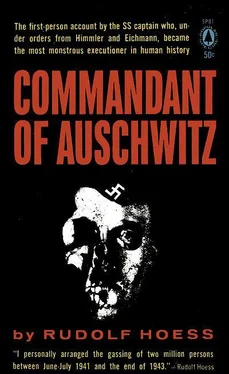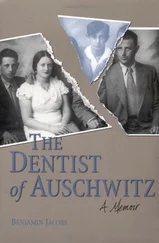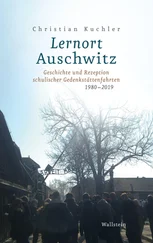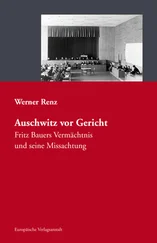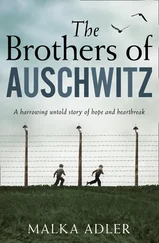The crematoriums were erected at the end of the two main thoroughfares in Birkenau camp, first, in order not to increase the area of the camp and consequently the safety precautions required, and second, so that they would not be too far from the camp, since it was planned to use the gas chambers and undressing rooms as bathhouses when the extermination actions came to an end.
The buildings were to be screened from view by a wall or hedges. Lack of material prevented this from being done. As a temporary measure, all extermination buildings were hidden under camouflage nets.
The three railroad tracks between building sectors I and II in Birkenau camp were to be reconstructed as a station and roofed in, and the lines were to be extended to crematoriums III and IV, so that the unloading would also be hidden from the eyes of unauthorized people. Once again shortage of materials prevented this plan from being carried out.
Because of the increasing insistence of the Reichsführer SS on the employment of prisoners in the armaments industry, Obergruppenführer Pohl found himself compelled to resort to Jews who had become unfit for work. The order was given that if the latter could be made fit and employable within six weeks, they were to be given special care and feeding. Up to then all Jews who had become incapable of working were gassed with the next transports, or killed by injection if they happened to be lying ill in the sick block. As far as Auschwitz-Birkenau was concerned, this order was sheer mockery. Everything was lacking. There were practically no medical supplies. The accommodation was such that there was scarcely even room for those who were most seriously ill. The food was completely insufficient, and every month the Food Ministry cut down the supplies still further. But all protests were unavailing and an attempt to carry out the order had to be made. The resultant overcrowding of the healthy prisoners could no longer be avoided. The general standard of health was thereby löwered, and diseases spread like wildfire. As a result of this order the death rate was sent up with a jerk and a tremendous deterioration in the general conditions developed. I do not believe that a single sick Jew was ever made fit again for work in the armaments industry.
During previous interrogations I have put the number of Jews who arrived in Auschwitz for extermination at two and a half million. This figure was supplied by Eichmann who gave it to my superior officers, Gruppenführer Glücks, when he was ordered to make a report to the Reichsführer SS shortly before Berlin was surrounded. Eichmann and his permanent deputy Günther were the only ones who possessed the necessary information on which to calculate the total number destroyed. In accordance with orders given by the Reichsführer SS, after every large action all evidence in Auschwitz on which a calculation of the number of victims might be based had to be burned.
As head of Department DII personally destroyed every bit of evidence which could be found in my office. The heads of other offices did the same.
According to Eichmann, the Reichsführer SS and the Reich Security Head Office also had all their data destroyed.
Only his personal notes could give the required information. It is possible that, owing to the negligence of some department or other, a few isolated documents, teletype messages, or radio messages have been left undestroyed, but they could not give sufficient information on which to make a calculation.
I myself never knew the total number and I have nothing to help me make an estimate of it.
I can only remember the figures involved in the larger actions, which were repeated to me by Eichmann or his deputies.
From Upper Silesia and Polish territory under German rule 250,000
Germany and Theresienstadt 100,000
Holland 95,000
Belgium 20,000
France 110,000
Greece 65,000
Hungary 400,000
Slovakia 90,000
I can no longer remember the figures for the smaller actions, but they were insignificant in comparison with the numbers given above.
I regard a total of two and a half million as far too high. Even Auschwitz had limits to its destructive possibilities.
Figures given by former prisoners are figments of the imagination and lack any foundation.
“Action Reinhardt” was the code name given to the collection, sorting, and utilization of all articles which were acquired as the result of the transports of Jews and their extermination.
Any member of the SS who laid hands on this Jewish property was, by order of the Reichsführer SS, punished with death.
Valuables worth many millions of dollars were seized.
An immense amount of property was stolen by members of the SS and by the police, and also by prisoners, civilian employees, and railway personnel. A great deal of this still lies hidden and buried in the Auschwitz-Birkenau camp area.
When the Jewish transports unloaded on arrival, their luggage was left on the platform until all the Jews had been taken to the extermination buildings or into the camp. During the early days all the luggage would then be brought by a transport detachment to the sorting office, Canada I, where it would be sorted and disinfected. The clothing of those who had been gassed in bunkers I and II or in crematoriums I to IV was also brought to the sorting office.
By 1942, Canada I could no longer keep up with the sorting. Although new huts and sheds were constantly being added and prisoners were sorting day and night, and although the number of persons employed was constantly stepped up and several trucks (often as many as twenty) were loaded daily with the items sorted out, the piles of unsorted luggage went on mounting up. So in 1942, the construction of Canada
II warehouse was begun at the west end of building sector II at Birkenau. A start was also made on the erection of extermination buildings and a bathhouse for the new arrivals. Thirty newly built huts were crammed to capacity immediately after completion, while mountains of unsorted effects piled up between them. In spite of the augmented labor gangs, it was out of the question to complete the job during the course of the individual actions, which always took from four to six weeks. Only during the longer intervals was it possible to achieve some semblance of order.
Clothing and footwear were examined for hidden valuables (although only cursorily in view of the quantities involved) and then stored or handed over to the camp to complete the inmates’ clothing. Later on, it was also sent to other camps.
A considerable part of the clothing was passed to welfare organizations for re-settlers and later for victims of air raids. Large and important munition plants received considerable quantities for their foreign workers.
Blankets and mattresses, etc. were also sent to the welfare organizations. In so far as the camp required articles of this nature they were retained to complete their inventory, but other camps also received large consignments.
Valuables were taken over by a special section of the camp command and sorted out by experts, and a similar procedure was followed with the money that was found.
The jewelry was usually of great value, particularly if its Jewish owners came from the West: precious stones worth thousands of dollars, priceless gold and platinum watches set with diamonds, rings, earrings, and necklaces of great rarity. Currency from all countries amounted to many thousands of dollars. Often tens of thousands of dollars in value, mostly in thousand-dollar notes, were found on single individuals. Every possible hiding place in their clothes and luggage and on their bodies was made use of.
When the sorting-out process that followed each major operation had been completed, the valuables and money were packed into trunks and taken by truck to the Economic Administration Head Office in Berlin and thence to the Reichsbank, where a special department dealt exclusively with items taken during actions against the Jews. Eichmann told me on one occasion that the jewelry and currency were sold in Switzerland, and that the entire Swiss jewelry market was dominated by these sales.
Читать дальше
